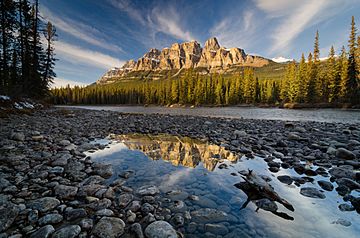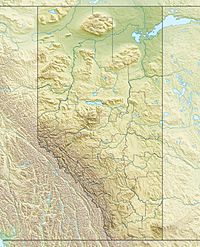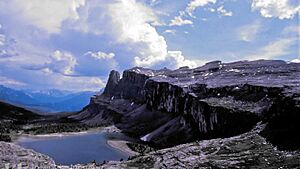Castle Mountain facts for kids
Quick facts for kids Castle Mountain |
|
|---|---|

Captured from the Bow River bank
|
|
| Highest point | |
| Elevation | 2,766 m (9,075 ft) |
| Prominence | 168 m (551 ft) |
| Listing | Mountains of Alberta |
| Naming | |
| Native name | Miistukskoowa (Blackfoot) |
| Geography | |
| Parent range | Sawback Range (Canadian Rockies) |
| Topo map | NTS 82O/05 |
| Climbing | |
| First ascent | 1884 by Arthur P. Coleman |
| Easiest route | Moderate scramble (NE) |
Castle Mountain (Blackfoot: Miistukskoowa) is a famous mountain in Banff National Park, Canada. It's located in the beautiful Canadian Rockies, between the towns of Banff and Lake Louise. The mountain gets its name because it truly looks like a giant castle!
This unique shape comes from how the mountain was formed. Different layers of rock, some soft like shale and some hard like limestone, were pushed up over time. Then, erosion (wind, water, and ice wearing away the rock) carved out the softer parts faster. This left the harder layers sticking out, creating the castle-like towers and walls you see today. Castle Mountain also sits on a major fault line called the Castle Mountain Fault. This is where older rocks were pushed over younger rocks, adding to its interesting structure.
Contents
Discovering Castle Mountain
Castle Mountain was named in 1858 by a explorer named James Hector. He thought it looked exactly like a castle. For a while, from 1946 to 1979, it was called Mount Eisenhower. This was to honor Dwight D. Eisenhower, a famous general from World War II. But people wanted the original name back. So, the mountain became Castle Mountain again. A tall rock tower on its side was then named Eisenhower Tower.
Near the mountain, you can find the remains of Silver City. This was a mining town from the 1800s. There was also a Castle Mountain Internment Camp here during World War I. People who were thought to be 'enemy sympathizers' were held there.
While Castle Mountain looks hard to climb from the main highway, you can hike up its northeastern side. A trail leads to Rockbound Lake, which is behind the mountain. The mountain has several high points. These include Helena Ridge (2,862 meters or 9,390 feet) and Stuart Knob (2,850 meters or 9,350 feet). There's also Television Peak (2,970 meters or 9,740 feet), named for a TV signal repeater on its top.
Mountain Geology Explained
Castle Mountain is the most eastern mountain in the Main Ranges of the Bow Valley. The Castle Mountain Fault runs right through it. This fault separates Castle Mountain from the nearby Sawback Range. The top parts of Castle Mountain are made of very old rocks. These include limestone, shale, and quartzite. These rocks were laid down in an ancient shallow sea. Later, they were pushed up and over younger rock layers. These younger layers now form the gentle, forested base of the mountain.
The mountain's unique shape is a great example of a "castellated" mountain. This means erosion has carved it into a series of flat areas and sharp cliffs. You can see alternating layers of softer shale and harder rocks like quartzite, dolomite, and limestone.
First Nations History
Castle Mountain is very important to the Siksika Nation. They call it Miistukskoowa. On January 25, 2017, the Government of Canada and the Siksika Nation reached an important agreement. This agreement settled a land claim that dated back to the 1880s.
At that time, land at Castle Mountain was set aside for the Siksika Nation to use for timber. But in 1908, these lands were taken from them without their permission or fair payment. In 1911, the lands became part of Rocky Mountain Park, which is now Banff National Park. The agreement gave the Siksika Nation about $123 million. It also gave them the chance to buy land outside the park. They can also apply to have this land added to their reserve. The agreement also ensures they have ongoing access to Banff National Park for cultural and traditional activities.
A Look Back in Time
Explorer James Hector first saw Castle Mountain in August 1858. He was looking for the start of the Bow River. He wrote that it looked "exactly like a gigantic castle." He named it Castle Mountain. He also made the first recorded climb on its lower slopes.
The first person to reach the very top of Castle Mountain was Arthur P. Coleman in 1884. He was a professor from the University of Toronto. Later, in 1926, Lawrence Grassi and P. Cerutti were the first to climb Eisenhower Tower.
In 1881, a man named Joe Healy got some ore from an Indigenous person. It had a lot of silver in it. The next year, he settled at Castle Mountain as a prospector. News of the silver spread quickly. Soon, many people arrived, and a town called Silver City grew fast near Castle Mountain. Over 3,000 people lived there at its busiest time. This was when the Canadian Pacific Railway was built through the area in 1884. But the mines didn't make much money, so Silver City was almost completely abandoned by 1885.
Near the mountain was the Castle Mountain Internment Camp. This was a camp during World War I. Many Ukrainian immigrants were held there. Life in these camps was very hard. The men held there were forced to work. Their labor helped build much of Banff National Park's roads and other structures.
In 1910, work began on a highway at Castle Junction. This road connected British Columbia to Calgary. When it was finished in the early 1920s, it made Castle Mountain much easier for hikers and tourists to visit.
In 1946, Prime Minister William Lyon Mackenzie King renamed Castle Mountain to Mount Eisenhower. He did this to honor General Dwight D. Eisenhower. King said that mountains were "more enduring" than castles. But many people in Banff were not happy with the new name. They wanted the original name back. After many years of requests, the mountain was officially renamed Castle Mountain in November 1979. The isolated pinnacle was then named Eisenhower Tower.
Exploring the Mountain
While Castle Mountain looks very challenging from the highway, it can be climbed. You can hike to Rockbound Lake, which is on the mountain's easier backside. There's a way through a cliff that lets you get higher up. Climbing the mountain from the trailhead can take a very long time, sometimes 12 hours for a round trip. It's important to know that you can't just camp anywhere in the backcountry here. Even in late summer, you might find snow patches on the higher routes. So, an ice axe might be a good idea for safety.




